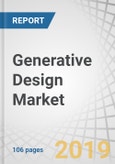Rising need for advanced product design software to drive product innovation is driving the growth of the market
Cost Optimization segment is expected to grow at the highest CAGR during the forecast period
By application, the cost optimization segment is expected to grow at the highest CAGR during the forecast period. Generative design is one such approach that enables designers to optimize fairly large and complex parameters such as material, energy, and time wastage. Hence, developing robust and efficient optimization algorithms to deal with resource wastage has been one of the major focus areas of industries.
Automotive industry vertical is estimated to be the largest adopter of generative design solutions in 2018
The automotive industry has always been at the forefront of adopting technologies for its product design and development. With rapid manufacturing advancements in the industry, generative design has gained a prominent place in achieving cost and production efficiency. Its use has increased to test and analyze designs of products in a virtual environment. Generative design software assists design engineers to reduce product design time, cost, and weight and improves the overall efficiency for automotive manufacturing and designing companies like General Motors, Hack Rod, and others.
Generative design market in Asia Pacific is projected to grow at the highest CAGR during the forecast period
The high growth of the market in Asia Pacific (APAC) is attributed to the rapid economic developments, favorable government policies, and increasing digitalization in the region with the increasing interest of businesses towards technologies such as Artificial Intelligence (AI). However, high installation costs, low acceptance of consumers, and changes in management processes remains the biggest hurdle in the adoption of generative design across the region. The cloud-based generative design tools present an optimal solution for these countries by minimizing integration complexities and installation costs.
In-depth interviews were conducted with the Chief Executive Officers (CEOs), marketing directors, other innovation and technology directors, and executives from various key organizations operating in the generative design market.
- By Company – Tier 1–10%, Tier 2–25%, and Tier 3–65%
- By Designation – C-Level–25%, Director Level–50%, and Others–25%
- By Region – North America–60%, Europe–20%, and APAC–10% RoW – 10%
The generative design market comprises major solution providers, such Altair (US), Autodesk (US), ANSYS (US), Dassault Systèmes (France), Desktop Metal (US), MSC Software (US), ESI Group (France), Bentley Systems (US), nTopology (US), and Paramatters (US). The study includes an in-depth competitive analysis of these key players in the generative design market with their company profiles, recent developments, and key market strategies.
Research Coverage
The market is segmented on the basis of application, component, deployment model, industry vertical, and region.
Key Benefits of the Report
The report would help the market leaders/new entrants in this market with the information on the closest approximations of the revenue numbers for the overall generative design market and the subsegments. This report would help stakeholders understand the competitive landscape and gain insights to better position their businesses and plan suitable go-to-market strategies. The report also helps stakeholders understand the pulse of the market and provides them with information on the key market drivers, restraints, challenges, and opportunities.
Table of Contents
Executive Summary
Companies Mentioned
- Altair
- Ansys
- Autodesk
- Bentley Systems
- Dassault Systèmes
- Desktop Metal
- ESI Group
- MSC Software
- Ntopology
- Paramatters
Table Information
| Report Attribute | Details |
|---|---|
| No. of Pages | 106 |
| Published | February 2019 |
| Forecast Period | 2018 - 2023 |
| Estimated Market Value ( USD | $ 111 million |
| Forecasted Market Value ( USD | $ 275 million |
| Compound Annual Growth Rate | 19.9% |
| Regions Covered | Global |
| No. of Companies Mentioned | 10 |









